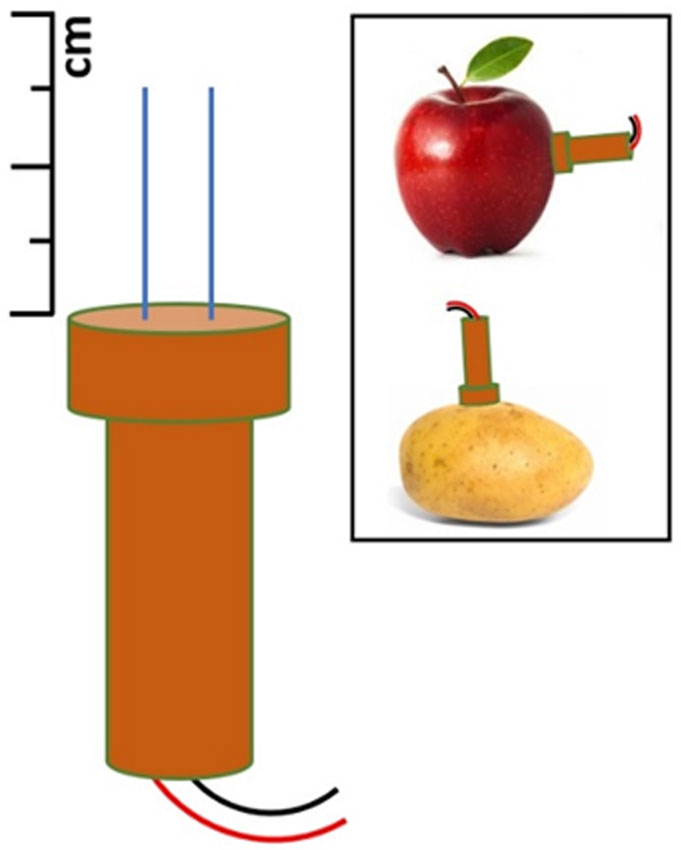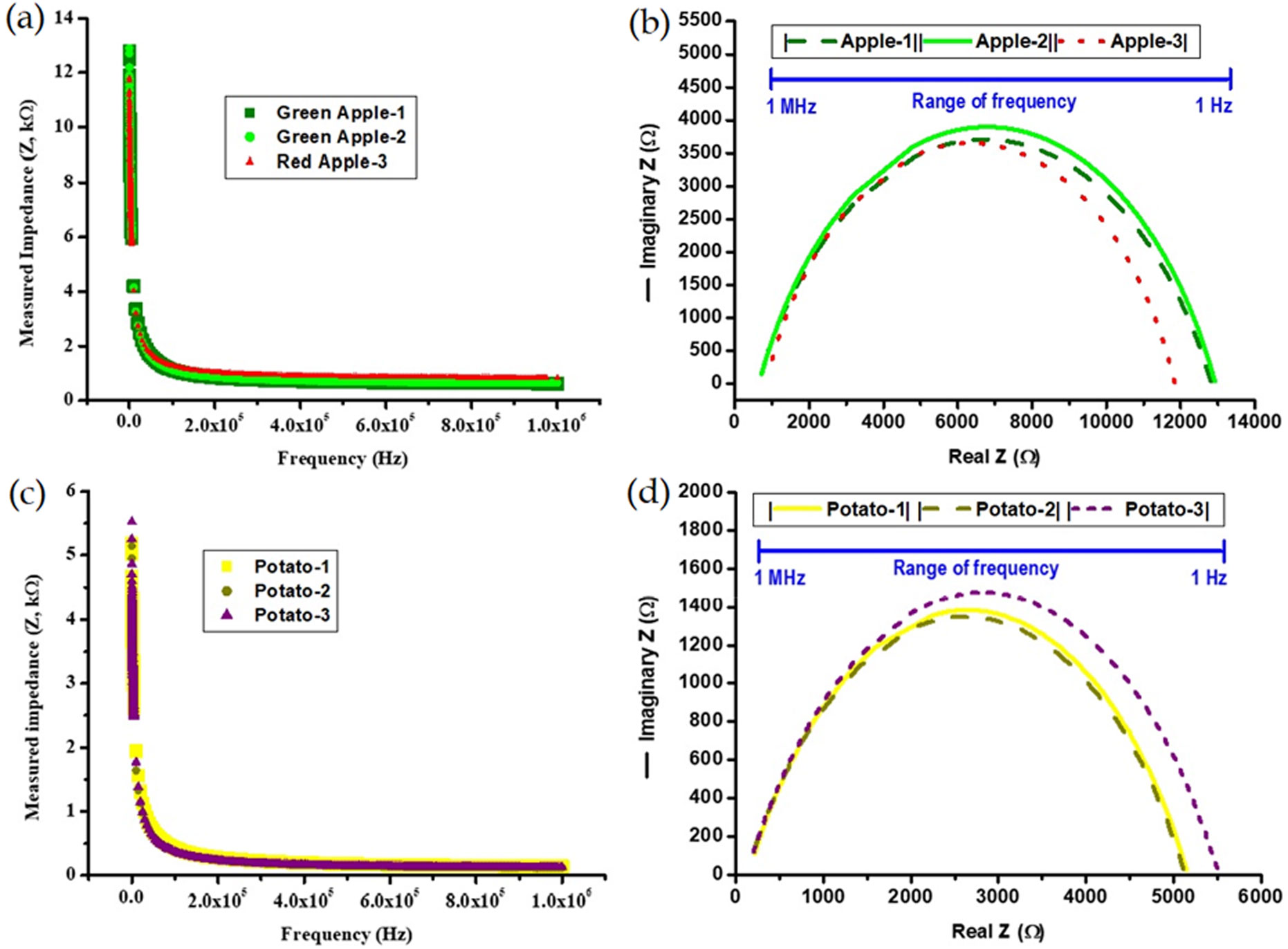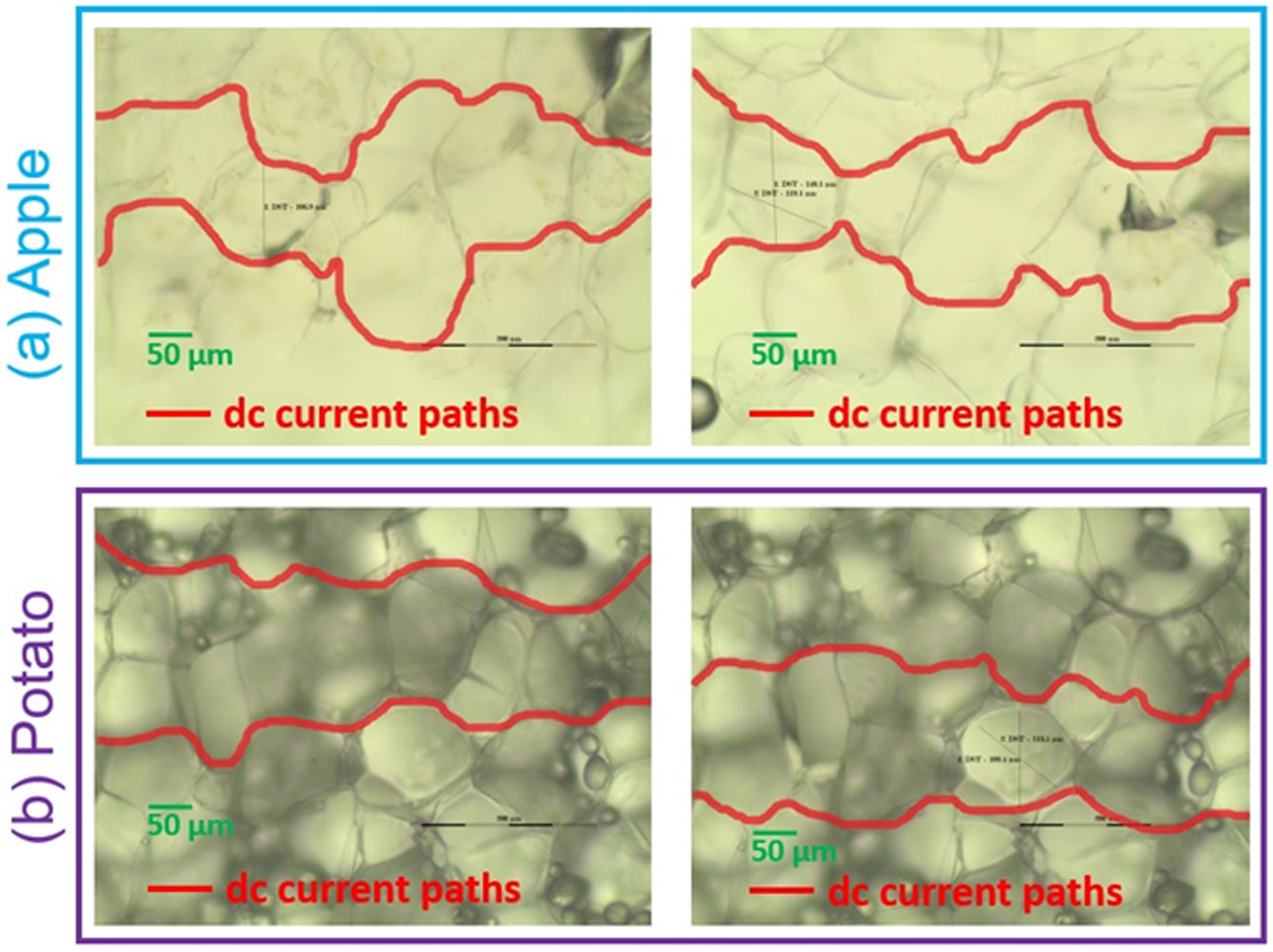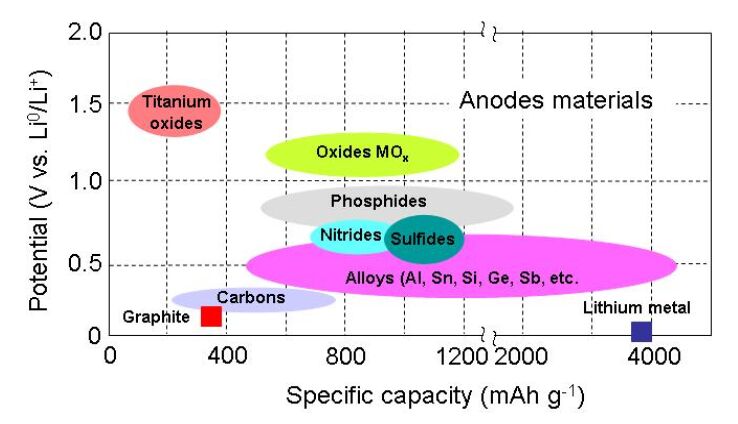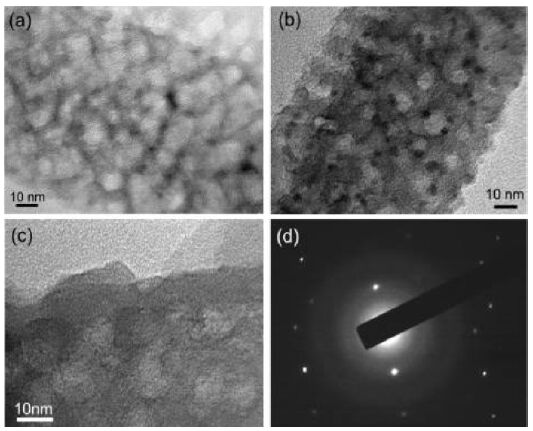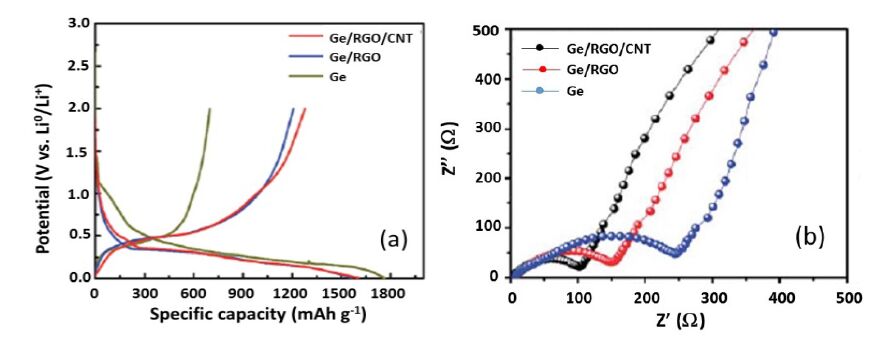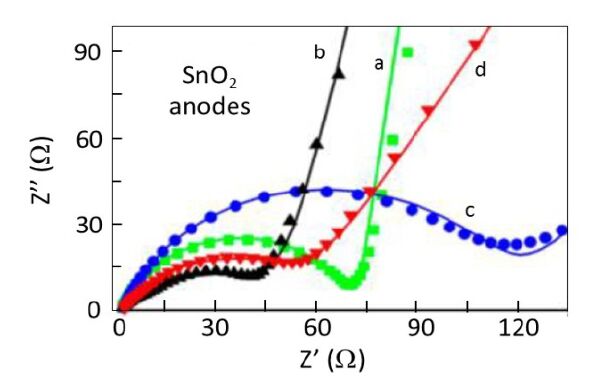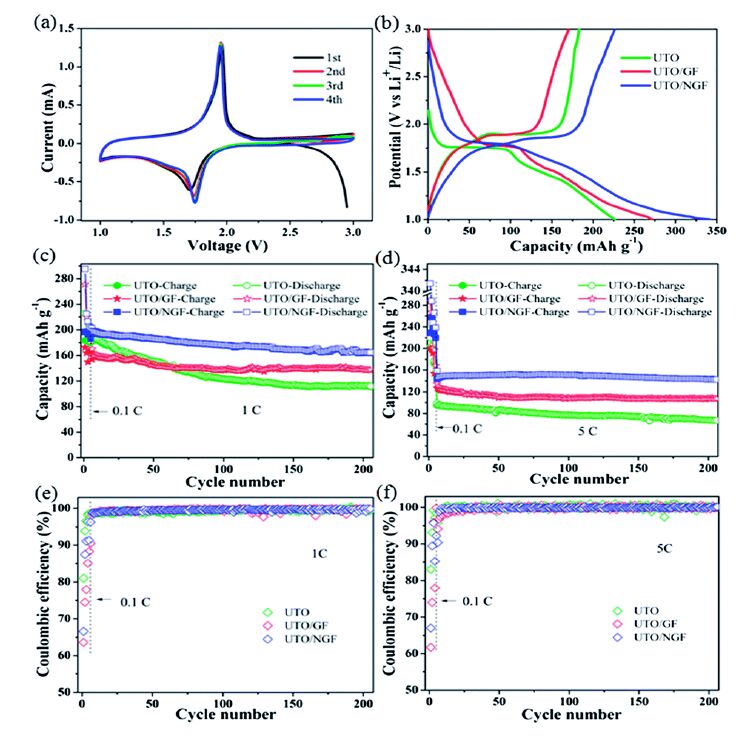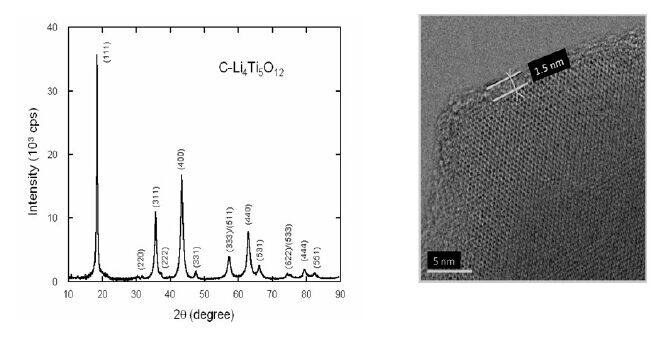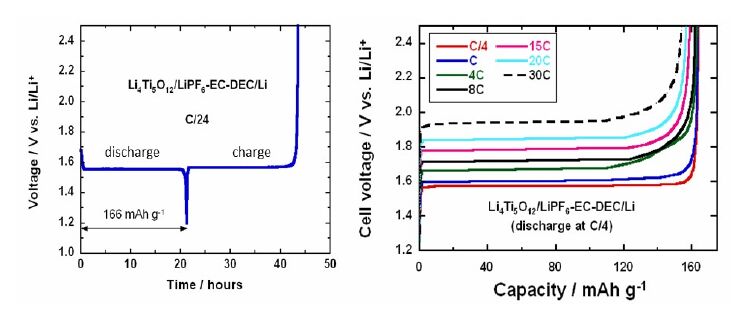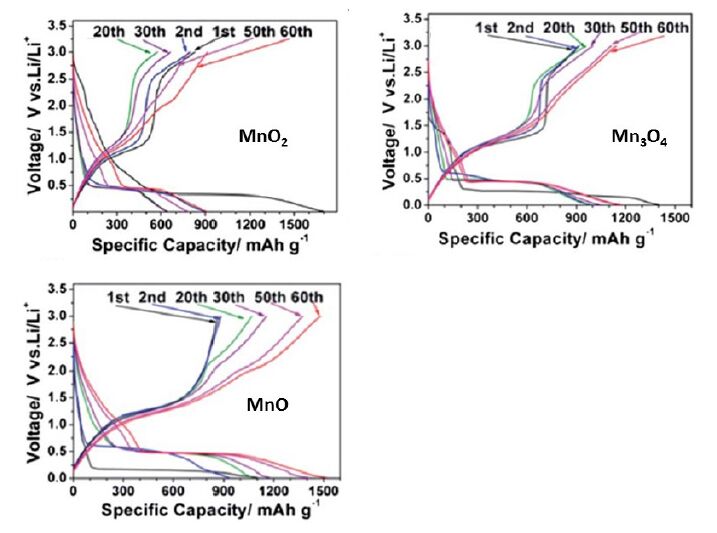|
[1]
|
Zaghib K, Mauger A, Julien CM (2015) Rechargeable lithium batteries for energy storage in smart grids, In: Rechargeable Lithium Batteries, Woodhead Publishing Series in Energy number 81, Elsevier.
|
|
[2]
|
Kasavajjula U, Wang C, Appleby AJ (2007) Nano- and bulk-silicon-based insertion anodes for lithium-ion secondary cells. J Power Sources 163: 1003–1039. doi: 10.1016/j.jpowsour.2006.09.084

|
|
[3]
|
Julien CM, Mauger A, Vijh A, et al. (2016) Lithium Batteries: Science and Technology, Springer, New York, 323–429.
|
|
[4]
|
Zhao K, Pharr M, Hartle L, et al. (2012) Fracture and debonding in lithium-ion batteries with electrodes of hollow core-shell nanostructures. J Power Sources 218: 6–14.
|
|
[5]
|
Ma ZS, Xie ZC, Wang Y, et al. (2015) Failure modes of hollow core-shell structural active materials during the lithiation-delithiation process. J Power Sources 290: 114–122.
|
|
[6]
|
Wang C, Ma Z, Wang Y, et al. (2016) Failure prediction of high-capacity electrode materials in lithium-ion batteries. J Electrochem Soc 163: A1157–A1163. doi: 10.1149/2.0251607jes

|
|
[7]
|
Jiang W, Li T, Ma Z, et al. (2015) Optimal design of hollow core-shell structural active materials for lithium ion batteries. Results in Phys 5: 250–252. doi: 10.1016/j.rinp.2015.08.010

|
|
[8]
|
Hu Y, Zhao X, Suo Z (2010) Averting cracks caused by insertion reaction in lithium-ion batteries. J Mater Res 25: 1007–1010. doi: 10.1557/JMR.2010.0142

|
|
[9]
|
Wang Y, Ma Z, Lei W, et al. (2016) Double effect of electrochemical reaction and substrate on hardness in electrodes of lithium-ion batteries. Acta Mechan 1–6.
|
|
[10]
|
Ma Z, Li T, Huang YL, et al. (2013) Critical silicon-anode size for averting lithiation-induced mechanical failure of lithium-ion batteries. RSC Adv 3: 7398–7402. doi: 10.1039/c3ra41052h

|
|
[11]
|
Haftbaradaran H, Gao H (2012) Ratcheting of silicon island electrodes on substrate due to cyclic intercalation. Appl Phys Lett 100: 121907. doi: 10.1063/1.3696298

|
|
[12]
|
Xie Z, Ma Z, Wang Y, et al. (2016) A kinetic model for diffusion and chemical reaction of silicon anode lithiation in lithium ion batteries. RSC Adv 6: 22383–22388. doi: 10.1039/C5RA27817A

|
|
[13]
|
Zhang P, Ma Z, Wang Y, et al. (2015) A first principles study of the mechanical properties of Li-Sn alloys. RSC Adv 5: 36022–36029. doi: 10.1039/C5RA04685H

|
|
[14]
|
Zhang P, Ma Z, Jiang W, et al. (2016) Mechanical properties of Li-Sn alloys for Li-ion battery anodes: A first-principles perspective. AIP Adv 6: 015107. doi: 10.1063/1.4940131

|
|
[15]
|
Gao X, Ma Z, Jiang W, et al. (2016) Stress-strain relationships of LixSn alloys for lithium ion batteries. J Power Sources 311: 21–28. doi: 10.1016/j.jpowsour.2016.02.024

|
|
[16]
|
Sony press news (2005) Available from: www.Sony.net/SonyInfo/News/Press/200502/05-006 E/index.html.
|
|
[17]
|
Agubra VA, Zuniga L, Flores D, et al. (2016) Composite nano-fibers as advanced materials for Li-ion, Li-O2 and Li-S batteries. Electrochim Acta 192: 529–550. doi: 10.1016/j.electacta.2016.02.012

|
|
[18]
|
Aravindan V, Sundaramurthy J, Kumar PS, et al. (2015) Electrospun nanofibers: A prospective electro-active material for constructing high performance Li-ion batteries. Chem Commun 51: 2225–2234. doi: 10.1039/C4CC07824A

|
|
[19]
|
Jung JW, Lee CL, Yu S, et al. (2016) Electrospun nanofibers as a platform for advanced secondary batteries: a comprehensive review. J Mater Chem A 4: 703–750.
|
|
[20]
|
Goodenough JB, KimY (2010) Challenges for rechargeable Li batteries. Chem Mater 22: 587–603. doi: 10.1021/cm901452z

|
|
[21]
|
Liu Y, Yang Y (2016) Recent progress of TiO2-based anodes for Li ion batteries. J Nanomater 2016: 1–15.
|
|
[22]
|
Zhang Y, Tang Y, Li W, et al. (2016) Nanostructured TiO2-based anode materials for high-performance rechargeable lithium-ion batteries. ChemNanoMat.
|
|
[23]
|
Rahman A, Wong Y, Song G, et al. (2015) A review on porous negative electrodes for high performance lithium-ion batteries. J Porous Mater 22: 1313–1343. doi: 10.1007/s10934-015-0010-1

|
|
[24]
|
Niu J, Zhang S, Niu Y, et al. (2015) Silicon-based anode materials for lithium-ion batteries. Prog Chem 27: 1275–1290.
|
|
[25]
|
Roy P, Srivastava K (2015) Nanostructured anode materials for lithium ion batteries. J Mater Chem A 3: 2454–2484. doi: 10.1039/C4TA04980B

|
|
[26]
|
Ji L, Lin Z, Alcoutlabi M, et al. (2011) Recent developments in nanostructured anode materials for rechargeable lithium-ion batteries. Energy Environ Sci 4: 22682–2699.
|
|
[27]
|
Zhang WJ (2011) A Review of the electrochemical performance of alloy anodes for lithium-ion batteries. J Power Sources 196: 13–24. doi: 10.1016/j.jpowsour.2010.07.020

|
|
[28]
|
Lou S, Cheng X, Ma Y, et al. (2015) Nb-based oxides as anode materials for lithium ion batteries. Prog Chem 27: 297–309.
|
|
[29]
|
Lahiri I, Oh SM, Hwang JY, et al. (2011) Ultrathin alumina-coated carbon nanotubes as an anode for high-capacity Li-ion batteries. J Mater Chem 21: 13621–13626. doi: 10.1039/c1jm11474c

|
|
[30]
|
Leung K, Qi Y, Zavadil KR, et al. (2011) Using atomic layer deposition to hinder solvent decomposition in lithium-ion batteries: first principles modeling and experimental studies. J Am Chem Soc 133: 14741–14754. doi: 10.1021/ja205119g

|
|
[31]
|
De Las Cazas C, Li WZ (2012) A review of application of carbon nanotubes for lithium-ion battery anode material. J Power Sources 208: 74–85. doi: 10.1016/j.jpowsour.2012.02.013

|
|
[32]
|
Fan S, Sun T, Rui X, et al. (2012) Cooperative enhancement of capacities in nanostructured SnSb/carbon nanotube network nanocomposite as anode for lithium ion batteries. J Power Sources 201: 288–293.
|
|
[33]
|
Wu Y, Wei Y, Wang J, et al. (2013) Conformal Fe3O4 sheath on aligned carbon nanotube scaffolds as high-performance anodes for lithium-ion batteries. Nano Lett 13: 818–823. doi: 10.1021/nl3046409

|
|
[34]
|
Ban C, Wu Z, Gillaspie DT, et al. (2010) Nanostructured Fe3O4/SWNT electrode: binder-free and high-rate Li-ion anode. Adv Energy Mater 22: E145–E149. doi: 10.1002/adma.200904285

|
|
[35]
|
Bindumadhavan K, Srivastava SK, Mahanty S (2013) MoS2-MWCNT hybrids as a superior anode in lithium-ion batteries. Chem Commun 49: 1823–1825. doi: 10.1039/c3cc38598a

|
|
[36]
|
Wang ZL, Xu D, Wang HG, et al. (2013) In-situ fabrication of porous graphene electrodes for high performance energy storage. ACS Nano 7: 2422–2430. doi: 10.1021/nn3057388

|
|
[37]
|
Lavoie N, Courtel F, Malenfant PRL, et al. (2013) Graphene-based composite anodes for lithium-ion batteries, In: Nanotechnology for Lithium-Ion Batteries, ed. by Y. Abdu-Lebdeh, I. Davidson, Springer, New York.
|
|
[38]
|
Fu YS, Zhu JW, Hu C, et al. (2014) Covalently coupled hybrid of graphitic carbon nitride with reduced graphene oxide as a superior performance lithium-ion battery anode. Nanoscale 6: 12555–12564. doi: 10.1039/C4NR03145H

|
|
[39]
|
Takamura T, Ohara S, Uehara M, et al. (2004) A vacuum deposited Si film having a Li extraction capacity over 2000 mAh g?1 with a long cycle life. J Power Sources 129: 96–100.
|
|
[40]
|
Ohara S, Suzuki J, Sekine K, et al. (2003) Li insertion/extraction reaction at a Si film evaporated on a Ni foil. J Power Sources 119–121: 591–596.
|
|
[41]
|
Chen LB, Xie JY, Yu HC, et al. (2009) An amorphous thin film Si anode with high capacity and long cycling life for lithium ion batteries. J Appl Electrochem 39: 1157–1162. doi: 10.1007/s10800-008-9774-1

|
|
[42]
|
Ohara S, Suzuki J, Sekine K, et al. (2004) A thin film silicon anode for Li-ion batteries having a very large specific capacity and long cycle life. J Power Sources 136: 303–306. doi: 10.1016/j.jpowsour.2004.03.014

|
|
[43]
|
Kim JB, Lee, HY, Lee KS, et al. (2003) Fe/Si multi-layer thin film anodes for lithium rechargeable thin film batteries. Electrochem Commun 5: 544–548. doi: 10.1016/S1388-2481(03)00120-6

|
|
[44]
|
Lee HY, Lee SM (2002) Graphite-FeSi alloy composites as anode materials for rechargeable lithium ion batteries. J Power Sources 112: 649–654. doi: 10.1016/S0378-7753(02)00461-5

|
|
[45]
|
Yu C, Li X, Ma T, et al. (2012) Silicon thin films as anodes for high-performance lithium-ion batteries with effective stress relaxation. Adv Energy Mater 2: 68–73. doi: 10.1002/aenm.201100634

|
|
[46]
|
Liu Y, Hudak NS, Huber DL, et al. (2011) In-situ transmission electron microscopy observation of pulverization of aluminum nanowires and evolution of the thin surface Al2O3 layers during lithiation-delithiation cycles. Nano Lett 11: 4188–4194. doi: 10.1021/nl202088h

|
|
[47]
|
Xiao X, Lu P, Dahn J (2011) Ultrathin multifunctional oxide coatings for lithium ion batteries. Adv Mater 23: 3911–3915. doi: 10.1002/adma.201101915

|
|
[48]
|
He Y, Yu X, Wang Y, et al. (2011) Alumina-coated patterned amorphous silicon as the anode for a lithium ion battery with high coulombic efficiency. Adv Mater 23: 4938–4941. doi: 10.1002/adma.201102568

|
|
[49]
|
Ge M, Rong J, Fang X, et al. (2012) Porous doped silicon nanowires for lithium ion battery anode with long cycle life. Nano Lett 12: 2318–2323. doi: 10.1021/nl300206e

|
|
[50]
|
Kim H, Cho J (2008) Superior lithium electroactive mesoporous Si@carbon core-shell nanowires for lithium battery anode material. Nano Lett 8: 3688–3691. doi: 10.1021/nl801853x

|
|
[51]
|
Lytle JC (2013) Inverse opal nanoarchitecture as lithium ion anode materials. In: Nanotechnology for Lithium-Ion Batteries, ed. by Y. Abdu-Lebdeh, I. Davidson, Springer, New York.
|
|
[52]
|
Chen HX, Dong ZX, Fu YP, et al. (2010) Silicon nanowires with and without carbon coating as anode materials for lithium ion batteries. J Solid State Electrochem 14: 1829–1834. doi: 10.1007/s10008-009-1001-4

|
|
[53]
|
Sethuraman VA, Kowolik K, Sirinavan V (2011) Increased cycling efficiency and rate capability of copper-coated silicon anode materials for lithium-ion batteries. J Power Sources 196: 6657–6662. doi: 10.1016/j.jpowsour.2010.12.075

|
|
[54]
|
Yao Y, Liu N, McDowell MT, et al. (2012) Improving the cycling stability of silicon nanowire anodes with conducting polymer coatings. Energy Environ Sci 5: 7927–7930. doi: 10.1039/c2ee21437g

|
|
[55]
|
Memarzadeh EL, Kalisvaart WP, Kohandehghan A, et al. (2012) Silicon nanowire core aluminium shell coaxial nanocomposites for lithium ion anodes grown with and without a TiN interlayer. J Mater Chem 22: 6655–6668. doi: 10.1039/c2jm16167b

|
|
[56]
|
Ruy I, Choi JW, Cui Y, et al. (2011) Size dependent fracture of Si nanowire battery anodes. J Mechan Phys Solids 59: 1717–1730. doi: 10.1016/j.jmps.2011.06.003

|
|
[57]
|
Liu XH, Zheng H, Zhong L, et al. (2011) Anisotropic swelling and fracture of silicon nanowires during lithiation. Nano Lett 11: 3312–3318. doi: 10.1021/nl201684d

|
|
[58]
|
Nguyen HT, Zamfir MR, Duong LD, et al. (2012) Alumina-coated silicon-based nanowire arrays for high quality Li-ion battery anodes. J Mater Chem 22: 24618–24626. doi: 10.1039/c2jm35125k

|
|
[59]
|
Wu H, Chan G, Choi JW, et al. (2012) Stable cycling for double-walled silicon nanotubes battery anodes through solid-electrolyte interphase control. Nano Technol 7: 310–315.
|
|
[60]
|
Song T, Cheng HY, Choi H, et al. (2012) Si/Ge double-layered nanotube array as a lithium ion battery anode. ACS Nano 6: 303–309. doi: 10.1021/nn203572n

|
|
[61]
|
Rong J, Fang X, Ge M, et al. (2013) Coaxial Si/anodic titanium oxide/Si nanotube arrays for lithium-ion battery anodes. Nano Res 6: 182–190. doi: 10.1007/s12274-013-0294-x

|
|
[62]
|
Choi NS, Yao Y, Cui Y, et al. (2011) One-dimensional Si/Sn-based nanowires and nanotubes for lithium-ion energy storage materials. J Mater Chem 21:9 825–9840.
|
|
[63]
|
Evanoff K, Kahn J, Balandin AA, et al. (2012) Towards ultra-thick battery electrodes: aligned carbon nanotube, enabled architecture. Adv Mater 24: 533–537. doi: 10.1002/adma.201103044

|
|
[64]
|
Krishnan R, Lu TM, Koratkar N (2011) Functionally strain-graded nanoscoops for High Power Li-Ion Battery Anodes. Nano Lett 11: 377–384. doi: 10.1021/nl102981d

|
|
[65]
|
Kim H, Han B, Choo J, et al. (2008) Three-dimensional porous silicon particles for uses in high-performance lithium secondary batteries. Angew Chem 47: 10151–10154. doi: 10.1002/anie.200804355

|
|
[66]
|
Son IH, Park JH, Kwon S, et al. (2015) Silicon carbide-free graphene growth on silicon for lithium-ion battery with high volumetric energy density. Nature Commun 6: 7393. doi: 10.1038/ncomms8393

|
|
[67]
|
Wu H, Zheng G, Liu N, et al. (2012) Engineering empty space between Si nanoparticles for lithium-ion battery anodes. Nano Lett 12: 904–909. doi: 10.1021/nl203967r

|
|
[68]
|
Liu N, Wu H, McDowell MT, et al. (2012) A yolk-shell design for stabilized and scalable li-ion battery alloy anodes. Nano Lett 12: 3315–3325. doi: 10.1021/nl3014814

|
|
[69]
|
Liu N, Lu Z, Zhao J, et al. (2014) A pomegranate-inspired nanoscale design for large-volume-change lithium battery anodes. Nat Nanotechnol 9: 187–190. doi: 10.1038/nnano.2014.6

|
|
[70]
|
Chou SL, Wang JZ, Choucair M, et al. (2010) Enhanced reversible lithium storage in a nanosize silicon/graphene composite. Electrochem Commun 12: 303–306. doi: 10.1016/j.elecom.2009.12.024

|
|
[71]
|
Wang JZ, Zhong C, Chou SL, et al. (2010) Flexible free-standing graphene-silicon composite film for lithium-ion batteries. Electrochem Commun 12: 1467–1470. doi: 10.1016/j.elecom.2010.08.008

|
|
[72]
|
Lee JK, Smith KB, Hayner CM, et al. (2010) Silicon nanoparticles-graphene paper composites for Li ion battery anodes. Chem Commun 46: 2025–2027. doi: 10.1039/b919738a

|
|
[73]
|
Chen S, Bao P, Huang X, et al. (2014) Hierarchical 3D mesoporous silicon@graphene nanoarchitectures for lithium ion batteries with superior performance. Nano Res 7: 85–94. doi: 10.1007/s12274-013-0374-y

|
|
[74]
|
Zhao X, Hayner CM, Kung MC, et al. (2011) In-plane vacancy-enabled high-power Si-graphene composite electrode for lithium-ion batteries. Adv Energy Mater 1: 1079–1084. doi: 10.1002/aenm.201100426

|
|
[75]
|
Zhao X, Li M, Chang KH, et al. (2014) Composites of graphene and encapsulated silicon for practically viable high-performance lithium-ion batteries. Nano Res 7: 1429–1438. doi: 10.1007/s12274-014-0463-6

|
|
[76]
|
Zamfir MR, Nguyen HT, Moyen E, et al. (2013) Silicon nanowires for Li-based battery anodes: a review. J Mat Chem A 1: 9566–9586. doi: 10.1039/c3ta11714f

|
|
[77]
|
Wen Z, Lu G, Mao S, et al. (2013) Silicon nanotube anode for lithium-ion batteries. Electrochem Commun 29: 67–70. doi: 10.1016/j.elecom.2013.01.015

|
|
[78]
|
Baggetto L, Notten PHN (2009) Lithium ion (de)insertion reaction of germanium thin-film electrodes and electrochemical and in-situ XRD study batteries and energy storage. J Electrochem Soc 156: A169–A175. doi: 10.1149/1.3055984

|
|
[79]
|
Liu XH, Huang S, Picraux ST, et al. (2011) Reversible nanopore formation in Ge nanowires during lithiation-delithiation cycling: an in-situ transmission electron microscopy study. Nano Lett 11: 3991–3997. doi: 10.1021/nl2024118

|
|
[80]
|
Liang W, Yang H, Fan F, et al. (2013) Tough germanium nanoparticles under electrochemical cycling. ACS Nano 7: 3427–3433. doi: 10.1021/nn400330h

|
|
[81]
|
Graetz J, Ahn CC, Yazami R, et al. (2004) Nano crystalline and thin film germanium electrodes with high lithium capacity and high rate capabilities. J Electrochem Soc 151: A698–A702 doi: 10.1149/1.1697412

|
|
[82]
|
Ren JG, Wu Q-H, Tang H, et al. (2013) Germanium-graphene composite anode for high-energy lithium batteries with long cycle life. J Mater Chem A 1: 1821–1826. doi: 10.1039/C2TA01286C

|
|
[83]
|
Fang S, Shan L, Zheng H, et al. (2015) Ge-graphene-carbon nanotube composite anode for high performance lithium-ion batteries. J Mater Chem A 3: 1498–1503. doi: 10.1039/C4TA04350B

|
|
[84]
|
DiLeo RA, Frisco S, Ganter MJ, et al. (2011) Hybris germanium nanoparticle—single wall carbon nanotube free-standing anodes for lithium batteries. J Phys Chem C 115: 22609–22614. doi: 10.1021/jp205992w

|
|
[85]
|
Ashuri M, He Q, Shaw LL (2016) Silicon as a potential anode material for Li-ion batteries: where size, geometry and structure matter. Nanoscale 8: 74–103. doi: 10.1039/C5NR05116A

|
|
[86]
|
Kamali AR, Fray DJ (2011) Tin-based as advanced anode materials for lithium-ion batteries: a review. Rev Adv Mater Sci 27: 14–24.
|
|
[87]
|
Youn DH, Heller A, Mullins CB (2016) Simple synthesis of nanostructured Sn/nitrogen-doped carbon composite using nitrilotriacetic acid as lithium ion Battery Anode. Chem Mater 28: 1343–1347. doi: 10.1021/acs.chemmater.5b04282

|
|
[88]
|
Yu Y, Gu L, Wang C, et al. (2009) Encapsulation of Sn-carbon nanoparticles in bamboo-like hollow carbon nanofibers as an anode material in lithium-based batteries. Angew Chem Int Ed 48: 6485–6489. doi: 10.1002/anie.200901723

|
|
[89]
|
Wang Y, Ma Z, Lu C (2016) A twins-structural Sn@C core-shell composite as anode materials for lithium-ion batteries. Compos Interface 23: 273–280. doi: 10.1080/09276440.2016.1136523

|
|
[90]
|
Liang S, Zhu X, Lian P, et al. (2011) Superior cycle performance of Sn@C/graphene nanocomposite as an anode material for lithium-ion batteries. J Solid Stat Chem 184: 1400–1404. doi: 10.1016/j.jssc.2011.03.052

|
|
[91]
|
Agubra VA, Zuniga L, De La Garza D, et al. (2016) Forcespinning: A new method for the mass production of Sn/C composite nano fiber anodes for lithium ion batteries. Solid State Ionics 286: 72–82. doi: 10.1016/j.ssi.2015.12.020

|
|
[92]
|
Beaulieu LY, Dahn JR (2000) The reaction of lithium with Sn-Mn-C intermetallics prepared by mechanical alloying. J Electrochem Soc 147: 3237–3241. doi: 10.1149/1.1393889

|
|
[93]
|
Mao O, Dunlap RA, Dahn JR (1999) Mechanically alloyed Sn-Fe-C powders as anode materials for Li-ion batteries. I. The Sn2Fe-C system. J Electrochem Soc 146: 405–413.
|
|
[94]
|
Mao O, Dahn JR (1999) Mechanically alloyed Sn-Fe-C powders as anode materials for Li-ion batteries. II. The Sn-Fe system. J Electrochem Soc 146: 414–422.
|
|
[95]
|
Mao O, Dahn J (1999) Mechanically alloyed Sn-Fe-C powders as anode materials for Li-ion batteries. III. Sn2Fe: SnFe3C active/inactive composites. J Electrochem Soc 146: 423–427.
|
|
[96]
|
Dahn JR, Mar RE, Abouzeid A (2006) Combinatorial study of Sn1-xCox (0 < x < 0.6) and [Sn0.55Co0.45]1-yCy (0 < y < 0.5) alloy negative electrode materials for Li-ion batteries. J Electrochem Soc 153: A361–A365.
|
|
[97]
|
Hassoun J, Ochal P, Panero S, et al. (2008) The effect of CoSn/CoSn2 phase ratio on the electrochemical behavior of Sn40Co40C20 ternary alloy electrodes in Li cells. J Power Sources 180: 568–575. doi: 10.1016/j.jpowsour.2008.01.059

|
|
[98]
|
Hassoun J, Mulas G, Panero S, et al. (2007) Ternary Sn-Co-C Li-ion battery electrode material prepared by high energy ball milling. Electrochem Commun 9: 2075–2081. doi: 10.1016/j.elecom.2007.05.033

|
|
[99]
|
Mukaibo H, Sumi T, Yokoshima T, et al. (2003) Electrodeposited Sn-Ni alloy film as a high capacity anode material for lithium-ion secondary batteries. Electrochem Solid-State Lett 6: A218–A220. doi: 10.1149/1.1602331

|
|
[100]
|
Wolfenstine J, Campos S, Foster D, et al. (2002) Nano-scale Cu6Sn5 anodes. J Power Sources 109: 230–233. doi: 10.1016/S0378-7753(02)00061-7

|
|
[101]
|
Ferguson PP, Todd ADW, Dahn JR (2008) Comparison of mechanically alloyed and suttered tin-cobalt-carbon as an anode material for lithium-ion batteries. Electrochem Commun 10: 25–31. doi: 10.1016/j.elecom.2007.10.025

|
|
[102]
|
Hassoun J, Panero S, Mulas G, et al. (2007) An electrochemical investigation of a Sn-Co-C ternary alloy as a negative electrode in Li-ion batteries. J Power Sources 171: 928–931. doi: 10.1016/j.jpowsour.2007.06.067

|
|
[103]
|
Sony corporation (2011) Sony the market for notebook PC; development of a tin-based amorphous anode for high-capacity rechargeable lithium-ion battery 3.5 Ah: the “Nexelion”. Available from: http:www.sony.co.jp/SonyInfo/News/Press/201107/11-078/.
|
|
[104]
|
Lei WX, Pan Y, Zhou YC, et al. (2014) CNTs-Cu composite layer enhanced Sn-Cu alloy as high performance anode materials for lithium-ion batteries. RSC Adv 4: 3233–3237. doi: 10.1039/C3RA44431G

|
|
[105]
|
Meschini I, Nobili F, Mancini M, et al. (2013) High performance Sn@carbon nanocomposite anode for lithium batteries. J Power Sources 226: 241–248. doi: 10.1016/j.jpowsour.2012.11.004

|
|
[106]
|
Jiang W, Zeng W, Ma Z, et al. (2014) Advanced amorphous nanoporous stannous oxide composite with carbon nanotubes as anode materials for lithium-ion batteries. RSC Adv 4: 41281–41286. doi: 10.1039/C4RA06968D

|
|
[107]
|
Zhu XJ, Guo ZP, Zhang P, et al. (2009) Highly porous reticular tin-cobalt oxide composite thin film anodes for lithium ion batteries. J Mater Chem 19: 8360–8365. doi: 10.1039/b913993a

|
|
[108]
|
Zhu XJ, Guo ZP, Zhang P, et al. (2010) Three-dimensional reticulartin-manganese oxide composite anode materials for lithium ion batteries. Electrochim Acta 55: 4982–4986.
|
|
[109]
|
Chen JS, Cheah YL, Chen YT, et al. (2009) SnO2 nanoparticles with controlled nano-coating as high-capacity anode for lithium-ion batteries. J Phys Chem 113: 20504–20508.
|
|
[110]
|
He M, Yuan L, Zhang W, et al. (2013) A SnO2-carbon nanocluster anode material with superior cyclablity and rate capability for lithium batteries. Nanoscale 5: 3298–3305. doi: 10.1039/c3nr34133j

|
|
[111]
|
Hassan MF, Rahman MM, Guo Z, et al. (2010) SnO2-NiO-C nanocomposite as a high capacity anode material for lithium-ion batteries. J Mater Chem 20: 9707–9712. doi: 10.1039/c0jm01341b

|
|
[112]
|
Yesibolati N, Shahid M, Chen W, et al. (2014) SnO2 anode surface passivation by atomic layer deposited HfO2 improves Li-ion battery performance. Small 10: 2849–2858. doi: 10.1002/smll.201303898

|
|
[113]
|
Du Z, Zhang S, Jiang T, et al. (2012) Facile synthesis of SnO2 nanocrystals coated conductive polymer nanowires for enhanced lithium storage. J Power Sources 219: 199–203. doi: 10.1016/j.jpowsour.2012.07.052

|
|
[114]
|
Lou XW, Li CM, Archer LA (2009) Design synthesis of coaxial SnO2@carbon hollow nanospheres for highly reversible lithium storage. Adv Mater 21: 2536–2539. doi: 10.1002/adma.200803439

|
|
[115]
|
Wang Z, Fierke MA, Stein A (2008) Porous carbon/tin oxide monoliths as anodes for lithium-ion batteries. J Electrochem Soc 155: A658–A663.
|
|
[116]
|
Zhang L, Wu HB, Liu B, et al. (2014) Formation of porous SnO2 microboxes via selective leaching for highly reversible lithium storage. Energy Environ Sci 7: 1013–1017. doi: 10.1039/c3ee43305f

|
|
[117]
|
Du G, Zhong C, Zhang P, et al. (2010) Tin dioxyde/carbon nanotube composites with high uniform SnO2 loading as anode materials for lithium ion batteries. Electrochim Acta 55: 2582–2586. doi: 10.1016/j.electacta.2009.12.031

|
|
[118]
|
Ren JR, Yang J, Abouimrane A, et al. (2011) SnO2 nanocrystals deposited on multiwalled carbon nanotubes with superior stability as anode material for Li-ion batteries. J Power Sources 196: 8701–8705. doi: 10.1016/j.jpowsour.2011.06.036

|
|
[119]
|
Zhu CL, Zhang ML, Qiao YJ, et al. (2010) High capacity and good cycling stability of multi-walled carbon nanotube/SnO2 core-shell structures as anode materials of lithium-ion batteries. Mater Res Bull 45: 437–441. doi: 10.1016/j.materresbull.2009.11.011

|
|
[120]
|
Wang Y, Zeng HC, Lee JY (2006) Highly reversible lithium storage in porous SnO2 nanotubes with coaxially grown carbon nanotubes overlayers. Adv Mater 18: 645–649. doi: 10.1002/adma.200501883

|
|
[121]
|
Zhang J, Ma Z, Jiang W, et al. (2016) Sandwich-like CNTs@SnO2/SnO/Sn anodes on three-dimensional Ni foam substrate for lithium ion batteries. J Electroanal Chem 767: 49–55.
|
|
[122]
|
Li YM, Lv XJ, Lu J, et al. (2010) Preparation of SnO2-nanocrystal/graphene-nanosheets composites and their lithium storage ability. J Phys Chem C 114: 21770–21774.
|
|
[123]
|
Zhao B, Zhang GH, Song JS, et al. (2011) Bivalent tin ion assisted reduction for preparing graphene/SnO2 composite with good cyclic performance and lithium storage capacity. Electrochim Acta 56: 7340–7346. doi: 10.1016/j.electacta.2011.06.037

|
|
[124]
|
Zhong C, Wang JZ, Chen ZX, et al. (2011) Photoinduced optical transparency in dye-sensitized solar cells containing graphene nanoribbons. J Phys Chem C 115: 25115–25131. doi: 10.1021/jp2061128

|
|
[125]
|
Lian PC, Zhu XF, Liang SZ, et al. (2011) High reversible capacity of SnO2/graphene nanocomposite as an anode material for lithium-ion batteries. Electrochim Acta 56: 4532–4539. doi: 10.1016/j.electacta.2011.01.126

|
|
[126]
|
Huang XD, Zhou XF, Zhou LA, et al. (2011) A facile one-step solvothermal synthesis of SnO2/graphene nanocomposite and its application as an anode material for lithium-ion batteries. ChemPhysChem 12: 278–281. doi: 10.1002/cphc.201000376

|
|
[127]
|
Xie J, Liu SY, Chen XF, et al. (2011) Nanocrystal-SnO2-loaded graphene with improved Li-storage properties prepared by a facile one-pot hydrothermal route. Int J Electrochem Sci 6: 5539–5549.
|
|
[128]
|
Baek S, Yu SH, Park SK, et al. (2011) A one-pot microwave-assisted non-aqueous sol-gel approach to metal oxide/graphene nanocomposites for Li-ion batteries. RSC Adv 1: 1687–1690. doi: 10.1039/c1ra00797a

|
|
[129]
|
Wang XY, Zhou XF, Yao K, et al. (2011) A SnO2/graphene composite as a high stability electrode for lithium ion batteries. Carbon 49: 133–139. doi: 10.1016/j.carbon.2010.08.052

|
|
[130]
|
Xu CH, Sun J, Gao L (2012) Direct growth of monodisperse SnO2 nanorods on graphene as high capacity anode materials for lithium ion batteries. J Mater Chem 22: 975–979. doi: 10.1039/C1JM14099J

|
|
[131]
|
Lin J, Peng Z, Xiang C, et al. (2013) Graphene nanoribbon and nanostructured SnO2 composite anodes for lithium ion batteries. ACS Nano 7: 6001–6007. doi: 10.1021/nn4016899

|
|
[132]
|
Zhou X, Wan LJ, Guo YG (2013) Binding SnO2 nanocrystals in nitrogen-doped graphene sheets as anode materials for lithium-ion batteries. Adv Mater 25: 2152–2157. doi: 10.1002/adma.201300071

|
|
[133]
|
Botas C, Carriazo D, Singh G, et al. (2015) Sn- and SnO2-graphene flexible foams suitable as binder-free anodes for lithium ion batteries. J Mater Chem A 25: 13402–13410.
|
|
[134]
|
Jiang W, Zhao X, Ma Z, et al. (2016) SnO2/reduced graphene oxide nanocomposite as anode material for lithium-ion batteries with enhanced cyclability. J Nanosci Nanotech 16: 4136–4140. doi: 10.1166/jnn.2016.12541

|
|
[135]
|
Sun J, Xiao L, Jiang S, et al. (2015) Fluorine-doped SnO2@graphene porous composite for high capacity lithium-ion batteries. Chem Mater 27: 4594–4603. doi: 10.1021/acs.chemmater.5b00885

|
|
[136]
|
Liu L, An M, Yang P, et al. (2015) Superior cycle performance and high reversible capacity of SnO2/graphene composite as an anode material for lithium-ion batteries. Sci Rep 5: 9055. doi: 10.1038/srep09055

|
|
[137]
|
Deng Y, Fang C, Chen G (2016) The developments of SnO2/graphene nanocomposites as anode materials for high performance lithium ion batteries: a review. J Power Sources 304: 81–101. doi: 10.1016/j.jpowsour.2015.11.017

|
|
[138]
|
Liu S, Wang R, Liu M, et al. (2014) Fe2O3-SnO2 nanoparticle decorated graphene flexible films as high-performance anode materials for lithium-ion batteries. J Mater Chem A 2: 4598–4604. doi: 10.1039/c3ta14897a

|
|
[139]
|
Bhaskar A, Deepa M, Ramakrishna M, et al. (2014) Poly(3,4-ethylenedioxythiophene) sheath over a SnO2 hollow spheres/graphene oxide hybrid for a durable anode in Li-ion batteries. J Phys Chem C 118: 7296–7306. doi: 10.1021/jp412038y

|
|
[140]
|
Ren H, Yu RB, Wang JY, et al. (2014) Multishelled TiO2 hollow microspheres as anodes with superior reversible capacity for lithium ion batteries. Nano Lett 14: 6679–6684.
|
|
[141]
|
Wang HY, Chen JZ, Hy S, et al. (2014) High-surface-area mesoporous TiO2 microspheres via one-step nanoparticle self-assembly for enhanced lithium-ion storage. Nanoscale 6: 14926–14931. doi: 10.1039/C4NR04729J

|
|
[142]
|
Xia T, Zhang W, Wang Z, et al. (2014) Amorphous carbon-coated TiO2 nanocrystals for improved lithium-ion battery and photocatalytic performance. Nano Energy 6: 109–118. doi: 10.1016/j.nanoen.2014.03.012

|
|
[143]
|
Acevedo-Peña P, Haro M, Rincón ME, et al. (2014) Facile kinetics of Li-ion intake causes superior rate capability in multiwalled carbon nanotube@TiO2 nanocomposite battery anodes. J Power Sources 268: 397–403. doi: 10.1016/j.jpowsour.2014.06.058

|
|
[144]
|
Jiang X, Yang X, Zhu Y, et al. (2014) 3D nitrogen-doped graphene foams embedded with ultrafine TiO2 nanoparticles for high-performance lithium-ion batteries. J Mater Chem A 2: 11124–11133.
|
|
[145]
|
Fu Y, Ming H, Zhou Q, et al. (2014) Nitrogen-doped carbon coating inside porous TiO2 using small nitrogen-containing molecules for improving performance of lithium-ion batteries. Electrochim Acta 134: 478–485.
|
|
[146]
|
Chen WN, Jiang H, Hu YJ, et al. (2014) Mesoporous single crystals Li4Ti5O12 grown on rGO as high-rate anode materials for lithium-ion batteries. Chem Commun 50: 8856–8859. doi: 10.1039/C4CC02886D

|
|
[147]
|
Xin X, Zhou XF, Wu JH, et al. (2012) Scalable synthesis of TiO2/graphene nanostructured composite with high-rate performance for lithium ion batteries. ACS Nano 6: 11035–11043. doi: 10.1021/nn304725m

|
|
[148]
|
Mo RW, Lei ZY, Sun KN, et al. (2014) Facile synthesis of anatase TiO2 quantum-dot/graphene-nanosheet composites with enhanced electrochemical performance for lithium-ion batteries. Adv Mater 26: 2084–2088. doi: 10.1002/adma.201304338

|
|
[149]
|
Wang J, Zhou Y, Xiong B, et al. (2013) Fast lithium-ion insertion of TiO2 nanotube and graphene composites. Electrochim Acta 88: 847–857. doi: 10.1016/j.electacta.2012.10.010

|
|
[150]
|
Zhang X, Zhang J, Liu Y, et al. (2015) Improving the anode performances of TiO2-carbon-rGO composites in lithium ion batteries by UV irradiation. New J Chem 39: 9345–9350. doi: 10.1039/C5NJ01855B

|
|
[151]
|
Zha CY, He DF, Zou JW, et al. (2014) A minky-dot-fabric-shaped composite of porous TiO2 microsphere/reduced graphene oxide for lithium ion batteries. J Mater Chem A 2: 16931–16938. doi: 10.1039/C4TA03675A

|
|
[152]
|
Fang Y, Lv Y, Che R, et al. (2013) Two-dimensional mesoporous carbon nanosheets and their derived graphene nanosheets: synthesis and efficient lithium ion storage. J Am Chem Soc 135: 1524–1530. doi: 10.1021/ja310849c

|
|
[153]
|
Lan T, Kiu H, Xie F, et al. (2015) Rutile TiO2mesocrystals/reduced graphene oxide with high-rate and long-term performance for lithium-ion batteries. Sci Rep 5: 8498. doi: 10.1038/srep08498

|
|
[154]
|
Liu H, Bi Z, Sun XG, et al. (2011) Mesoporous TiO2-B microspheres with superior rate performance for lithium ion batteries. Adv Mater 23: 3450–3454. doi: 10.1002/adma.201100599

|
|
[155]
|
Yang Z, Du G, Guo Z, et al. (2011) TiO2(B)-carbon composite nanowires as anode for lithium ion batteries with enhanced reversible capacity and cyclic performance. J Mater Chem 21: 8591–8596. doi: 10.1039/c0jm03873c

|
|
[156]
|
Yan X, Li Y, Li M, et al. (2015) Ultrafast lithium storage in TiO2-bronze nanowires/N-doped graphene nanocomposites. J Mater Chem A 3: 4180–4187. doi: 10.1039/C4TA06361A

|
|
[157]
|
Etacheri V, Yourey JE, Bartlett BM (2014) Chemically bonded TiO2-Bronze nanosheet/reduced graphene oxide hybrid for high-power lithium ion batteries. ACS Nano 8: 1491–1499. doi: 10.1021/nn405534r

|
|
[158]
|
Li MS, Li XF, Li WH, et al. (2015) Atomic layer deposition derived amorphous TiO2 thin film decorating graphene nanosheets with superior rate capability. Electrochem Commun 57: 43–47. doi: 10.1016/j.elecom.2015.05.005

|
|
[159]
|
Luo J, Xia X, Luo Y, et al. (2013) Rationally designed hierarchical TiO2/Fe2O3 hollow nanostructures for improved lithium ion storage. Adv Energy Mater 3: 737–743. doi: 10.1002/aenm.201200953

|
|
[160]
|
Liao JY, Higgins D, Lui G, et al. (2013) Multifunctional TiO2-C/MnO2 core-double-shell nanowire arrays as high-performance 3D electrodes for lithium ion batteries. Nano Lett 13: 5467–5473. doi: 10.1021/nl4030159

|
|
[161]
|
Jeun JH, Park KY, Kim DH, et al. (2013) SnO2@TiO2 double-shell nanotubes for a lithium ion battery anode with excellent high rate cyclability. Nanoscale 5: 8480–8483. doi: 10.1039/c3nr01964k

|
|
[162]
|
Jung HG, Myung ST, Yoon CS, et al. (2011) Microscale spherical carbon-coated Li4Ti5O12 as ultra high power anode material for lithium batteries. Energy Environ Sci 4: 1345–1351. doi: 10.1039/c0ee00620c

|
|
[163]
|
Zaghib K, Dontigny M, Guerfi A, et al. (2012) An improved high-power battery with increased thermal operating range: C-LiFePO4/C-Li4Ti5O12. J Power Sources 216: 192–200. doi: 10.1016/j.jpowsour.2012.05.025

|
|
[164]
|
Li B, Han C, He YB, et al. (2012) Facile synthesis of Li4Ti5O12/C composite with super rate performance. Energy Environ Sci 5: 9595–9602. doi: 10.1039/c2ee22591c

|
|
[165]
|
Zhao L, Hu YS, Li H, et al. (2011) Porous Li4Ti5O12 coated with N-doped carbon from ionic liquids for Li-ion batteries. Adv Mater 23: 1385–1388. doi: 10.1002/adma.201003294

|
|
[166]
|
Fan L, Tan X, Yu T, et al. (2016) Li4Ti5O12/hollow graphitized nano-carbon composites as anode materials for lithium ion battery. RCS Adv 6: 26406–26411.
|
|
[167]
|
Shen L, Yuan C, Luo H, et al. (2011) Novel template-free solvothermal synthesis of mesoporous Li4Ti5O12-C microspheres for high power lithium ion batteries. J Mater Chem 21: 14414–14416. doi: 10.1039/c1jm12324f

|
|
[168]
|
Lin C, Fan X, Yin Y, et al. (2014) Mono-dispersed mesoporous Li4Ti5O12 submicrospheres as anode materials for lithium-ion batteries: morphology and electrochemical performances. Nanoscale 21: 6651–6650.
|
|
[169]
|
Jhan YR, Duh JG (2012) Synthesis of entanglement structure in nanosized Li4Ti5O12/multi-walled carbon nanotubes composite anode material for Li-ion batteries by ball-milling-assisted solid-state reaction. J Power Sources 198: 294–297. doi: 10.1016/j.jpowsour.2011.09.063

|
|
[170]
|
Shi Y, Wen L, Li F, et al. (2011) Nanosized Li4Ti5O12/graphene hybrid materials with low polarization for high rate lithium ion batteries. J Power Sources 196: 8610–8617. doi: 10.1016/j.jpowsour.2011.06.002

|
|
[171]
|
Li X, Qu M, Huai Y, et al. (2010) Preparation and electrochemical performance of Li4Ti5O12/carbon/carbon nanotubes for lithium ion battery. Electrochim Acta 55: 2978–2982. doi: 10.1016/j.electacta.2010.01.015

|
|
[172]
|
Jhan YR, Duh JG (2012) Synthesis of entanglement structure in nanosized Li4Ti5O12/multi-walled carbon nanotubes composite anode material for Li-ion batteries by ball-milling-assisted solid-state reaction. J Power Sources 198: 294–297. doi: 10.1016/j.jpowsour.2011.09.063

|
|
[173]
|
Ni H, Fan LZ (2012) Nano-Li4Ti5O12 anchored on carbon nanotubes by liquid phase deposition as anode material for high rate lithium-ion batteries. J Power Sources 214: 195–199. doi: 10.1016/j.jpowsour.2012.04.074

|
|
[174]
|
Shen L, Yuan C, Luo H, et al. (2012) In situ growth of Li4Ti5O12 on multi-walled carbon nanotubes: novel coaxial nanocables for high rate lithium ion batteries. J Mater Chem 21: 761–767.
|
|
[175]
|
Zhu N, Liu W, Xue MQ, et al. (2010) Graphene as a conductive additive to enhance the high-rate capabilities of electrospun Li4Ti5O12 for lithium-ion batteries. Electrochim Acta 55: 5813–5818. doi: 10.1016/j.electacta.2010.05.029

|
|
[176]
|
Ge H, Hao T, Osgood H, et al. (2016) Advanced mesoporous spinel Li4Ti5O12/rGO composites with increased surface lithium storage capability for high-power lithium-ion batteries. ACS Appl Mater Inter 8: 9162–9169. doi: 10.1021/acsami.6b01644

|
|
[177]
|
Chen C, Agrawal R, Wang C (2015) High performance Li4Ti5O12/Si composite anodes for Li-ion batteries. Nanomaterials 5: 1469–1480. doi: 10.3390/nano5031469

|
|
[178]
|
Li N, Mei T, Zhu Y, et al. (2012) Hydrothermal synthesis of layered Li1.81H0.19Ti2O5·xH2O nanosheets and their transformation to single-crystalline Li4Ti5O12 nanosheets as the anode materials for Li-ion batteries. CrystEngComm 14: 6435–6440.
|
|
[179]
|
Liu GY, Wang HY, Liu GQ, et al. (2013) Synthesis and electrochemical performance of high-rate dual-phase Li4Ti5O12-TiO2 nanocrystallines for Li-ion batteries. Electrochim Acta 87: 218–223. doi: 10.1016/j.electacta.2012.09.010

|
|
[180]
|
Xu C, Xue L, Zhang W, et al. (2014) Hydrothermal synthesis of Li4Ti5O12/TiO2 nano-composite as high performance anode material for Li-ion batteries. Electrochim Acta 147: 506–512. doi: 10.1016/j.electacta.2014.09.060

|
|
[181]
|
Zhong H, Yang G, Song H, et al. (2012) Vertically aligned graphene-like SnS2 ultrathin nanosheet arrays: excellent energy storage, catalysis, photoconduction, and field-emitting performances. J Phys Chem C 116: 9319–9326. doi: 10.1021/jp301024d

|
|
[182]
|
Du Y, Yin Z, Rui X, et al. (2013) A facile, relative green, and inexpensive synthetic approach toward large-scale production of SnS2 nanoplates for high-performance lithium-ion batteries. Nanoscale 5: 1456–1459. doi: 10.1039/c2nr33458e

|
|
[183]
|
He M, Yuan LX, Huang YH (2013) Acetylene black incorporated three-dimensional porous SnS2 nanoflowers with high performance for lithium storage. RSC Adv 3: 3374–3383. doi: 10.1039/c2ra22764a

|
|
[184]
|
Li J, Wu P, Lou F, et al. (2013) Mesoporous carbon anchored with SnS2 nanosheets as an advanced anode for lithium-ion batteries. Electrochim Acta 111: 862–868. doi: 10.1016/j.electacta.2013.08.104

|
|
[185]
|
Sun H, Ahmad M, Luo J, et al. (2014) SnS2 nanoflakes decorated multiwalled carbon nanotubes as high performance anode materials for lithium-ion batteries. Mater Res Bull 49: 319–324. doi: 10.1016/j.materresbull.2013.09.005

|
|
[186]
|
Balogun MS, Qiu W, Jian J, et al. (2015) Vanadium nitride nanowire supported SnS2 nanosheets with high Reversible capacity as anode material for lithium ion batteries. ACS Appl Mater Inter 7: 23205–23215.
|
|
[187]
|
Wang Q, Huang Y, Miao J, et al. (2013) Graphene-supported Ce-SnS2 nanocomposite as anode material for lithium-ion batteries. J Am Ceram Soc 96: 2190–2196. doi: 10.1111/jace.12302

|
|
[188]
|
Chen P, Su Y, Liu H, et al. (2013) Interconnected tin disulfide nanosheets grown on graphene for Li-ion storage and photocatalytic applications. ACS Appl Mater Inter 5: 12073–12082. doi: 10.1021/am403905x

|
|
[189]
|
Chang K, Wang Z, Huang G, et al. (2012) Few-layer SnS2/graphene hybrid with exceptional electrochemical performance as lithium-ion battery anode. J Power Sources 201: 259–266. doi: 10.1016/j.jpowsour.2011.10.132

|
|
[190]
|
Zhuo L, Wu Y, Wang L, et al. (2012) One-step hydrothermal synthesis of SnS2/graphene composites as anode material for highly efficient rechargeable lithium ion batteries. RSC Adv 2: 5084–5087. doi: 10.1039/c2ra00002d

|
|
[191]
|
Yin J, Cao H, Zhou Z, et al. (2012) SnS2@reduced graphene oxide nanocomposites as anode materials with high capacity for rechargeable lithium ion batteries. J Mater Chem 22: 23963–23970. doi: 10.1039/c2jm35137d

|
|
[192]
|
Wang Q, Nie YX, He B, et al. (2014) SnS2/graphene nanocomposites as anodes of lithium-ion batteries. Solid State Sci 31: 81–84. doi: 10.1016/j.solidstatesciences.2014.03.001

|
|
[193]
|
Liu S, Lu X, Xie J, et al. (2013) Preferential c-axis orientation of ultrathin SnS2 nanoplates on graphene as high-performance anode for Li-ion batteries. ACS Appl Mater Inter 5: 1588–1595. doi: 10.1021/am302124f

|
|
[194]
|
Zhang Q, Li R, Zhang M, et al. (2014) SnS2/reduced graphene oxide nanocomposites with superior lithium storage performance. Electrochim Acta 115: 425–433. doi: 10.1016/j.electacta.2013.10.193

|
|
[195]
|
Mei L, Xu C, Yang T, et al. (2013) Superior electrochemical performance of ultra-small SnS2 nanocrystals decorated on flexible RGO in lithium-ion batteries. J Mater Chem A 1: 8658–8664. doi: 10.1039/c3ta11269a

|
|
[196]
|
Luo B, Fang Y, Wang B, et al. (2012) Two dimensional grapheme-SnS2 hybrids with superior rate capability for lithium ion storage. Energy Environ Sci 5: 5226–5230. doi: 10.1039/C1EE02800F

|
|
[197]
|
Qin J, He C, Zhao N, et al. (2014) Graphene networks anchored with Sn@graphene as lithium ion battery anode. ACS Nano 8: 1728–1738. doi: 10.1021/nn406105n

|
|
[198]
|
Jiang X, Yang X, Zhu Y, et al. (2013) In situ assembly of graphene sheets-supported SnS2 nanoplates into 3D macroporous aerogels for high-performance lithium ion batteries. J Power Sources 237: 178–186. doi: 10.1016/j.jpowsour.2013.03.048

|
|
[199]
|
Zhao Y, Li X, Yan B, et al. (2015) Significant impact of 2D graphene nanosheets on large volume change tin-based anodes in lithium-ion batteries: A review. J Power Sources 274: 869–884.
|
|
[200]
|
Lei WX, Pan Y, Zhou YC, et al. (2014) CNTs-Cu composite layer enhanced Sn-Cu alloy as high performance anode materials for lithium-ion batteries. RSC Adv 4: 3233–3237. doi: 10.1039/C3RA44431G

|
|
[201]
|
Chen SY, Wang ZX, Fang XP, et al. (2011) characterization of TiS2 as an anode material for lithium ion batteries. Acta Phys Chim Sin 27: 97–102.
|
|
[202]
|
Kartick B, Srivastava SK, Mahanty S (2013) TiS2-MWCNT hybrid as highperformance anode in lithium-ion battery. J Nanopart Res 15: 1950–1962. doi: 10.1007/s11051-013-1950-5

|
|
[203]
|
Deng D (2015) Li-ion batteries: basics, progress, and challenges. Energy Sci Eng 3: 385–418. doi: 10.1002/ese3.95

|
|
[204]
|
Rui X, Tan H, Yan Q (2014) Nanostructured metal sulfides for energy storage. Nanoscale 6: 9889–9924. doi: 10.1039/C4NR03057E

|
|
[205]
|
Son MY, Choi JH, Kang YC (2014) Electrochemical properties of bare nickel sulfide and nickel sulfide-carbon composites prepared by one-pot spray pyrolysis as anode materials for lithium secondary batteries. J Power Sources 251: 480–487. doi: 10.1016/j.jpowsour.2013.10.093

|
|
[206]
|
Aso K, Sakuda A, Hayashi A, et al. (2013) All-solid-state lithium secondary batteries using NiS-carbon fiber composite electrodes coated with Li2S-P2S5 solid electrolytes by pulsed laser deposition. ACS Appl Mater Inter 5: 686–690. doi: 10.1021/am302164e

|
|
[207]
|
Aso K, Hayashi A, Tatsusago M (2012) Synthesis of NiS-carbon fiber composites in high-boiling solvent to improve electrochemical performance in all-solid-state lithium secondary batteries. Electrochim Acta 83: 448–453. doi: 10.1016/j.electacta.2012.07.088

|
|
[208]
|
Sebastian ST, Jagan RS, Rajagoplan R, et al. (2014) Lithium-ion storage performance of camphoric carbon wrapped NiS nano/micro-hybrids RSC Adv 4: 11673–11679.
|
|
[209]
|
Geng H, Kong SF, Wang Y (2014) NiS nanorod-assembled nanoflowers grown on graphene: morphology evolution and Li-ion storage applications. J Mater Chem A 2: 15152–15158. doi: 10.1039/C4TA03440F

|
|
[210]
|
Pan Q, Xie J, Liu S, et al. (2013) Facile one-pot synthesis of ultrathin NiS nanosheets anchored on graphene and the improved electrochemical Li-storage properties. RSC Adv 3: 3899–3906. doi: 10.1039/c2ra22410k

|
|
[211]
|
Zhou W, Zheng JL, Yue YH, et al. (2015) Highly stable rGO-wrapped Ni3S2 nanobowls: Structure fabrication and superior long-life electrochemical performance in LIBs. Nano Energy 11: 428-435.
|
|
[212]
|
Gao Z, Song N, Zhang Y, et al. (2015) Cotton-textile-enabled, flexible lithium-ion batteries with enhanced capacity and extended lifespan. Nano Lett 15: 8194-8203.
|
|
[213]
|
Chen Q, Chen W, Ye JB, et al. (2015) L-Cysteine-assisted hydrothermal synthesis of nickel disulfide/graphene composite with enhanced electrochemical performance for reversible lithium storage. J Power Sources 294: 51–58. doi: 10.1016/j.jpowsour.2015.06.071

|
|
[214]
|
Mahmoud N, Zhang C, Hou Y (2013) Nickel sul?de/nitrogen-doped graphene composites: phase-controlled synthesis and high performance a increased the grafting of node materials for lithium ion batteries. Small 9: 1321–1328.
|
|
[215]
|
Reddy ALM, Srivastava A, Gowda SR, et al. (2010) Synthesis of nitrogen-doped graphene films for lithium battery application. ACS Nano 4: 6337–6342. doi: 10.1021/nn101926g

|
|
[216]
|
Zhou Y, Yan D, Xu H, et al. (2015) Hollow nanospheres of mesoporous Co9S8 as a high-capacity and long-life anode for advanced lithium ion batteries. Nano Energy 12: 528-537.
|
|
[217]
|
Shi W, Zhu J, Rui X, et al. (2012) Controlled synthesis of carbon-coated cobalt sulfide nanostructures in oil phase with Enhanced Li Storage Performances. ACS Appl Mater Inter 4: 2999-3006.
|
|
[218]
|
Gu Y, Wang Y (2013) Graphene-Wrapped CoS Nanoparticles for high-capacity lithium-ion storage. ACS Appl Mater Inter 5: 801–806. doi: 10.1021/am3023652

|
|
[219]
|
Zhang D, Mai YJ, Xiang JY, et al. (2012) FeS2/C composite as an anode for lithium ion batteries with enhanced reversible capacity. J Power Sources 217: 229–235. doi: 10.1016/j.jpowsour.2012.05.112

|
|
[220]
|
Gan Y, Xu F, Luo J, et al. (2016) One-pot biotemplate synthesis of FeS decorated sulfur-doped carbon fiber as high capacity anode for lithium-ion batteries. Electrochim Acta 209: 201–209. doi: 10.1016/j.electacta.2016.05.076

|
|
[221]
|
Wen X, Wei X, Yang L, et al. (2015) Self-assembled FeS2 cubes anchored on reduced graphene oxide as an anode material for lithium ion batteries. J Mater Chem A 3: 2090–2096. doi: 10.1039/C4TA05575F

|
|
[222]
|
Zhang SS, Tran DT (2015) Electrochemical verification of the redox mechanism of FeS2 in a rechargeable lithium battery. Electrochim Acta 176: 784–789. doi: 10.1016/j.electacta.2015.07.096

|
|
[223]
|
Cao F, Pan GX, Chen J, et al. (2016) Synthesis of pyrite/carbon shells on cobalt nanowires forming core/branch arrays as high-performance cathode for lithium ion batteries. J Power Sources 303: 35–40. doi: 10.1016/j.jpowsour.2015.10.096

|
|
[224]
|
Cui H, Zhu G, Liu X, et al. (2015) Niobium nitride Nb4N5 as a new high-performance electrode material for supercapacitors. Adv Sci 2: 1500126. doi: 10.1002/advs.201500126

|
|
[225]
|
Fu ZW, Wang Y, Yue XL, et al. (2004) Electrochemical reactions of lithium with transition metal nitride electrodes. J Phys Chem B 108: 2236–2244. doi: 10.1021/jp030530s

|
|
[226]
|
Balogun MS, Qiu W, Wang W, et al. (2015) Recent advances in metal nitrides as high-performance electrode materials for energy storage devices. J Mater Chem A 3: 1364–1387. doi: 10.1039/C4TA05565A

|
|
[227]
|
Miller TS, Jorge AB, Sella A, et al. (2015) The use of graphitic carbon nitride based composite anodes for lithium-ion battery applications. Electroanal 27: 2614–2619. doi: 10.1002/elan.201500205

|
|
[228]
|
Tan G, Wu F, Yuan Y, et al. (2016) Free standing three-dimensional core-shell nanoarrays for lithium-ion battery anodes. Nature Commun 7: 11774. doi: 10.1038/ncomms11774

|
|
[229]
|
Wang Y, Ding X, Huang L, et al. (2015) Critical influence of carbon nitride self-assembly coating on the electrochemical performance of SnO2-TiO2 nanocomposite anode material for lithium ion battery. Int J Electrochem Sci 11: 2461–2472.
|
|
[230]
|
Ulvestad A, Maehlen JP, Kirkengen M (2015) Silicon nitride coated silicon thin films as anodes for Li-ion batteries. ECS Trans 64: 107–111.
|
|
[231]
|
Wang R, Lang J, Zghang P, et al. (2015) Fast and large lithium storage in 3D porous VN nanowires-graphene composite as a superior anode toward high-performance hybrid supercapacitors. Adv Func Mater 25: 2270–2278.
|
|
[232]
|
Zhang K, Wang H, He X, et al. (2011) A hybrid material of vanadium nitride and nitrogen-doped graphene for lithium storage. J Mater Chem 21: 11916–11922. doi: 10.1039/c1jm11710f

|
|
[233]
|
Lei D, Yang T, Qu B, et al. (2014) Synthesis of TiN@C nanocomposites for enhanced electrochemical properties. Sustain Ener 2: 1–4. doi: 10.7569/JSEE.2014.629502

|
|
[234]
|
Zheng H, Fang S, Tong Z, et al. (2015) Stabilized titanium nitride nanowire supported silicon core-shell nanorods as high capacity lithium-ion anodes. J Mater Chem A 3: 12476–12481. doi: 10.1039/C5TA02259B

|
|
[235]
|
Zhang J, Zhang J, Cai W, et al. (2012) Improving electrochemical properties of spinel lithium titanate by incorporation of titanium nitride via high-energy ball-milling. J Power Sources 211: 133–139. doi: 10.1016/j.jpowsour.2012.03.088

|
|
[236]
|
Yue Y, Han P, He X, et al. (2012) In situ synthesis of a graphene/titanium nitride hybrid material with highly improved performance for lithium storage. J Mater Chem 22: 4938–4943. doi: 10.1039/c2jm16128a

|
|
[237]
|
Liu M, Zhang L, Han P, et al. (2015) Controllable formation of niobium nitride/nitrogen-doped graphene nanocomposites as anode materials for lithium-ion capacitors. Part Part Syst Charact 32: 1006–1011. doi: 10.1002/ppsc.201500095

|
|
[238]
|
Li Y, Yan Y, Ming H, et al. (2014) One-step synthesis Fe3N surface-modified Fe3O4 nanoparticles with excellent lithium storage ability. Appl Surf Sci 305: 683–688. doi: 10.1016/j.apsusc.2014.03.169

|
|
[239]
|
Liu J, Tang S, Lu Y, et al. (2013) Synthesis of MoN nanolayer coated MoO2 hollow nanostructures as high-performance anode materials for lithium-ion batteries. Energy Environ Sci 6: 2691–2697. doi: 10.1039/c3ee41006d

|
|
[240]
|
Sun Q, Fu ZW (2012) Mn3N2 as a novel negative electrode material for rechargeable lithium batteries. Appl Surf Sci 258: 3197–3201. doi: 10.1016/j.apsusc.2011.11.063

|
|
[241]
|
Wu Y, Liu M, Feng H, et al. (2014) Carbon coated MnO@Mn3N2 core-shell composites for high performance lithium ion battery anodes. Nanoscale 6: 14697–14701. doi: 10.1039/C4NR05043F

|
|
[242]
|
Zhang L, Hu P, Zhao X, et al. (2011) Controllable synthesis of core-shell Co-CoO nanocomposites with a superior performance as an anode material for lithium-ion batteries. J Mater Chem 21: 18279–18283. doi: 10.1039/c1jm12990b

|
|
[243]
|
Xiong S, Chen JS, Lou XW, et al. (2012) Mesoporous Co3O4 and CoO-C topotactically transformed from chrysanthemum-like Co(CO3)0.5(OH)·0.11H2O and their lithium-storage properties. Adv Funct Mater 22: 861–871.
|
|
[244]
|
Qi Y, Du N, Zhang H, et al. (2012) CoO/NiSix core-shell nanowire arrays as lithium-ion anodes with high rate capabilities. Nanoscale 4: 991–996. doi: 10.1039/C2NR11545J

|
|
[245]
|
Qi Y, Du N, Zhang H, et al. (2012) Nanostructured hybrid cobalt oxide/copper electrodes of lithium-ion batteries with reversible high-rate capabilities. J Alloy Compd 521: 83–89. doi: 10.1016/j.jallcom.2012.01.046

|
|
[246]
|
Zhao W, Du N, Zhang H, et al. (2016) A novel Co-Li2O@Si core-shell nanowire array composite as a high-performance lithium-ion battery anode material. Nanoscale 8: 4511-4519. doi: 10.1039/C5NR06120B

|
|
[247]
|
Nethravathi C, Rajamathi CR, Rajamathi M, et al. (2013) N-doped graphene-VO2(B) nanosheet-built 3D flower hybrid for lithium ion battery. ACS Appl Mater Inter 5: 2708–2714. doi: 10.1021/am400202v

|
|
[248]
|
Zhang L, Wang Z, Yang K, et al. (2016) Preparation and electrochemical performances of CoO/3D graphene composite as anode for lithium-ion batteries. J Alloy Compd 656: 278–283. doi: 10.1016/j.jallcom.2015.09.208

|
|
[249]
|
Qi Y, Zhang H, Du N, et al. (2013) Highly loaded CoO/graphene nanocomposites as lithium-ion anodes with superior reversible capacity. J Mat Chem A 1: 2337–2342. doi: 10.1039/c2ta00929c

|
|
[250]
|
Zhu J, Zhu T, Zhou X, et al. (2011) Facile synthesis of metal oxide/reduced graphene oxide hybrids with high lithium storage capacity and stable cyclability. Nanoscale 3: 1084–1089. doi: 10.1039/C0NR00744G

|
|
[251]
|
Peng C, Chen B, Qin Y, et al. (2012) Facile ultrasonic synthesis of CoO quantum dot/graphene nanosheet composites with high lithium storage capacity. ACS Nano 6: 1074–1081. doi: 10.1021/nn202888d

|
|
[252]
|
Sun Y, Hu X, Luo W, et al. (2012) Ultrathin CoO/graphene hybrid nanosheets: a highly stable anode material for lithium-ion batteries. J Phys Chem C 116: 20794–20799. doi: 10.1021/jp3070147

|
|
[253]
|
Verrelli R, Hassoun J (2015) High-capacity NiO-(mesocarbon microbeads) conversion anode for lithium-ion battery. ChemElectroChem 2: 988–994. doi: 10.1002/celc.201500069

|
|
[254]
|
Sun X, Yan C, Chen Y, et al. (2014) Three-dimensionally curved NiO nanomembranes as ultrahigh rate capability anodes for Li-ion batteries with long cycle lifetimes. Adv Energy Mater 4.
|
|
[255]
|
Chen X, Zhang N, Sun K (2012) Facile ammonia-induced fabrication of nanoporous NiO films with enhanced lithium-storage properties. Electrochem Commun 20: 137–140. doi: 10.1016/j.elecom.2012.04.009

|
|
[256]
|
Huang XH, Yuan YF, Wang Z, et al. (2011) Electrochemical properties of NiO/Co-P nanocomposite as anode materials for lithium ion batteries. J Alloy Compd 509: 3425–3429. doi: 10.1016/j.jallcom.2010.12.117

|
|
[257]
|
Zou Y, Wang Y (2011) NiO nanosheets grown on graphene nanosheets as superior anode materials for Li-ion batteries. Nanoscale 3: 2615–2620. doi: 10.1039/c1nr10070j

|
|
[258]
|
Huang Y, Huang XL, Lian JS, et al. (2012) Self-assembly of ultrathin porous NiO nanosheets/graphene hierarchical structure for high-capacity and high-rate lithium storage. J Mater Chem 22: 2844–2847. doi: 10.1039/c2jm15865e

|
|
[259]
|
Zhu XJ, Hu J, Dai HL, et al. (2012) Reduced graphene oxide and nanosheet-based nickel oxide microsphere composite as an anode material for lithium ion battery. Electrochim Acta 64: 23–28. doi: 10.1016/j.electacta.2011.12.040

|
|
[260]
|
Choi SH, Ko YN, Lee JK, et al. (2014) Rapid continuous synthesis of spherical reduced graphene ball-nickel oxide composite for lithium ion batteries. Sci Rep 4: 5786. doi: 10.1038/srep05786

|
|
[261]
|
Zhou F, Chen Y, Liu K, et al. (2016) Metal organic frameworks derived hierarchical hollow NiO/Ni/graphene composites for lithium and sodium storage. ACS Nano 10: 377-386.
|
|
[262]
|
Zhong KF, Xia X, Zhang B, et al. (2010) MnO powder as anode active materials for lithium ion batteries. J Power Sources 195: 3300–3308. doi: 10.1016/j.jpowsour.2009.11.133

|
|
[263]
|
Li SR, Sun Y, Ge SY, et al. (2012) A facile route to synthesize nano-MnO/C composites and their application in lithium ion batteries. Chem Eng J 192: 226–231. doi: 10.1016/j.cej.2012.04.009

|
|
[264]
|
Zhong K, Zhang B, Luo S, et al. (2011) Investigation on porous MnO microsphere anode for lithium ion batteries. J Power Sources 196: 6802–6808. doi: 10.1016/j.jpowsour.2010.10.031

|
|
[265]
|
Tang X, Sui G, Cai Q, et al. (2016) Novel MnO/carbon composite anode material with multi-modal pore structure for high performance lithium-ion batteries. J Mater Chem A 4: 2082–2088. doi: 10.1039/C5TA10073A

|
|
[266]
|
Xia Y, Xiao Z, Dou X, et al. (2013) Green and facile fabrication of hollow porous MnO/C microspheres from microalgaes for lithium-ion batteries. ACS Nano 7: 7083–7092. doi: 10.1021/nn4023894

|
|
[267]
|
Yue J, Gu X, Wang N, et al. (2014) General synthesis of hollow MnO2, Mn3O4 and MnO nanospheres as superior anode materials for lithium ion batteries. J Mater Chem A 2: 17421–17426. doi: 10.1039/C4TA03924F

|
|
[268]
|
Liu B, Hu X, Xu H, et al. (2014) Encapsulation of MnO nanocrystals in electrospun carbon nanofibers as high-performance anode materials for lithium-ion batteries. Sci Rep 4: 4229.
|
|
[269]
|
Sun Y, Hu X, Luo W, et al. (2013) Reconstruction of conformal nanoscale MnO on graphene as a high-capacity and long-life anode material for lithium ion batteries. Adv Func Mater 23: 2436–2443. doi: 10.1002/adfm.201202623

|
|
[270]
|
Jiang H, Hu YJ, Guo SJ, et al. (2014) Rational design of MnO/carbon nanopeapods with internal void space for high-rate and long-life Li-ion batteries. ACS Nano 8: 6038–6046. doi: 10.1021/nn501310n

|
|
[271]
|
Wang Y, Han ZJ, Yu SF, et al. (2013) Core-leaf onion-like carbon/MnO2 hybrid nano-urchins for rechargeable lithium-ion batteries. Carbon 64: 230–236. doi: 10.1016/j.carbon.2013.07.057

|
|
[272]
|
Lai H, Li JX, Chen ZG, et al. (2012). Carbon nanohorns as a high-performance carrier for MnO2 anode in lithium-ion batteries. ACS Appl Mater Inter 4: 2325–2328. doi: 10.1021/am300378w

|
|
[273]
|
Xia H, Lai M, Lu L (2010) Nanoflaky MnO2/carbon nanotube nanocomposites as anode materials for lithium-ion batteries. J Mater Chem 20: 6896–6902. doi: 10.1039/c0jm00759e

|
|
[274]
|
Yun YS, Kim JM, Park HH, et al. (2013) Free-standing heterogeneous hybrid papers based on mesoporous γ-MnO2 particles and carbon nanotubes for lithium-ion battery anodes. J Power Sources 244: 747–751. doi: 10.1016/j.jpowsour.2012.11.056

|
|
[275]
|
Yu AP, Park HW, Davies A, et al. (2011) Free-standing layer-by-layer hybrid thin film of graphene-MnO2 nanotube as anode for lithium ion batteries. J Phys Chem Lett 2: 1855–1860. doi: 10.1021/jz200836h

|
|
[276]
|
Li L, Raji ARO, Tour JM (2013) Graphene-wrapped MnO2-graphene nanoribbons as anode materials for high-performance lithium ion batteries. Adv Mater 25: 6298–6302. doi: 10.1002/adma.201302915

|
|
[277]
|
Li YY, Zhang QW, Zhu JL, et al. (2014) An extremely stable MnO2 anode incorporated with 3D porous graphene-like networks for lithium-ion batteries. J Mater Chem A 2: 3163–3168. doi: 10.1039/c3ta14372d

|
|
[278]
|
Luo W, Hu X, Sun Y, et al. (2011) Electrospinning of carbon-coated Mo2 nanofibers with enhanced lithium-storage properties. Phys Chem Chem Phys 13: 16735–16740. doi: 10.1039/c1cp22184a

|
|
[279]
|
Liu B, Zhao X, Tian Y, et al. (2013) A simple reduction process to synthesize MoO2/C composites with cage-like structure for high-performance lithium-ion batteries. Phys Chem Chem Phys 15: 8831–8837. doi: 10.1039/c3cp44707c

|
|
[280]
|
Gao Q, Yang L, Lu X, et al. (2010) Synthesis, characterization and lithium-storage performance of MoO2/carbon hybrid nanowires. J Mater Chem 20: 2807–2812.
|
|
[281]
|
Zeng L, Zheng C, Deng C, et al. (2013) MoO2-ordered mesoporous carbon nanocomposite as an anode material for lithium-ion batteries. ACS Appl Mater Inter 5: 2182–2187. doi: 10.1021/am303286n

|
|
[282]
|
Ihsan M, Wang H, Majid SR, et al. (2016) MoO2/Mo2C/C spheres as anode materials for lithium ion batteries. Carbon 96: 1200–1207. doi: 10.1016/j.carbon.2015.10.076

|
|
[283]
|
Xu Y, Yi R, Yuan B, et al. (2012) High capacity MoO2/graphite oxide composite anode for lithium-ion batteries. J Phys Chem Lett 3: 309–314.
|
|
[284]
|
Sun Y, Hu X, Luo W, et al. (2011) Self-assembled hierarchical MoO2/graphene nanoarchitectures and their application as a high-performance anode material for lithium-ion batteries. ACS Nano 5: 7100–7107. doi: 10.1021/nn201802c

|
|
[285]
|
Tang Q, Shan Z, Wang L, et al. (2012) MoO2-graphene nanocomposite as anode material for lithium-ion batteries. Electrochim Acta 79: 148–153. doi: 10.1016/j.electacta.2012.06.093

|
|
[286]
|
Hou Y, Li JY, Wen ZH, et al. (2014) N-doped graphene/porous g-C3N4 nanosheets supported layered-MoS2 hybrid as robust anode materials for lithium-ion batteries. Nano Energy 8: 157–164. doi: 10.1016/j.nanoen.2014.06.003

|
|
[287]
|
Kumar V, Lee PS (2015) Redox active polyaniline-h-MoO3 hollow nanorods for improved pseudocapacitive performance. J Phys Chem C 119: 9041–9049. doi: 10.1021/acs.jpcc.5b00153

|
|
[288]
|
Brezesinski T, Wang J, Tolbert SH, et al. (2010) Ordered mesoporous α-MoO3 with iso-oriented nanocrystalline walls for thin-film pseudocapacitors. Nat Mater 9: 146–151. doi: 10.1038/nmat2612

|
|
[289]
|
Zhou K, Zhou W, Liu X, et al. (2015) Ultrathin MoO3 nanocrystals self-assembled on graphene nanosheets via oxygen bonding as supercapacitor electrodes of high capacitance and long cycle life. Nano Energy 12: 510–520. doi: 10.1016/j.nanoen.2015.01.017

|
|
[290]
|
Han B, Lee KH, Lee YW, et al. (2015) MoO3 nanostructured electrodes prepared via hydrothermal process for lithium ion batteries. Int J Electrochem Sci 10: 4232–4240..
|
|
[291]
|
Wang Q, Sun J, Wang Q, et al. (2015) Electrochemical performance of α-MoO3-In2O3 core-shell nanorods as anode materials for lithium-ion batteries. J Mater Chem A 3: 5083–5091.
|
|
[292]
|
Hamed B, Shahid M, Nagae-raju DH, et al. (2015) Surface passivation of MoO3 nanorods by atomic layer deposition toward high rate durable Li ion battery anodes. ACS Appl Mater Inter 7: 13154–13163. doi: 10.1021/acsami.5b03395

|
|
[293]
|
Zhao G, Li C, Zhang L, et al. (2015) “Sea cucumber”-like Ti@MoO3 nanorod arrays as self-supported lithium ion battery anodes with enhanced rate capability and durability. J Mater Chem A 3: 22547–22551.
|
|
[294]
|
Ma F, Yuan A, Xu J, et al. (2015) Porous α-MoO3/MWCNT nanocomposite synthesized via a surfactant-assisted solvothermal route as a lithium-ion-battery high-capacity anode material with excellent rate capability and cyclability. ACS Appl Mater Inter 7: 15531–15541. doi: 10.1021/acsami.5b03953

|
|
[295]
|
Tauseef A, Li W, Li J, et al. (2016) Lithium storage study on MoO3-grafted TiO2 nanotube arrays. Appl Nanoscience [in press].
|
|
[296]
|
Xue XY, Chen ZH, Xing LL, et al. (2011) SnO2/MoO3 core-shell nanobelts and their extraordinarily high reversible capacity as lithium-ion battery anodes. Chem Commun 47: 5205–5207. doi: 10.1039/c1cc00076d

|
|
[297]
|
Hashem AM, Abbas SB, Abdel-Ghany AE, et al. (2016) Blend formed by oxygen deficient MoO3?δ oxides as lithium-insertion compounds. J Alloy Compd 686: 744–752.
|
|
[298]
|
Bruck A, Cama CA, Gannett CN, et al. (2016) Nanocrystalline iron oxide based electroactive materials in lithium ion batteries: the critical role of crystallite size, morphology, and electrode heterostructure on battery relevant electrochemistry. Inorg Chem Front 3: 26–40. doi: 10.1039/C5QI00247H

|
|
[299]
|
Zhang WM, Wu XL, Hu JS, et al. (2008) Carbon-coated Fe3O4 nanospindles as a superior anode material for lithium-ion batteries. Adv Funct Mater 18: 3941–3946. doi: 10.1002/adfm.200801386

|
|
[300]
|
Zhu T, Chen JS, Lou XW (2011) Glucose-assisted one-pot synthesis of FeOOH nanorods and their transformation to Fe3O4@carbon nanorods for application in lithium ion batteries. J Phys Chem C 115: 9814–9820. doi: 10.1021/jp2013754

|
|
[301]
|
Chen JS, Zhang YM, Lou XW (2011) One-pot synthesis of uniform Fe3O4 nanospheres. ACS Appl Mater Inter 3: 3276–3279. doi: 10.1021/am201079z

|
|
[302]
|
Wang ZY, Luan DY, Madhavi S, et al. (2012) Assembling carbon-coated γ-Fe2O3 hollow nanohorns on the CNT backbone for superior lithium storage capability. Energ Environ Sci 5: 5252–5256. doi: 10.1039/C1EE02831F

|
|
[303]
|
Ji L, Toprakci O, Alcoutlabi M, et al. (2012) α-Fe2O3 nanoparticle-loaded carbon nanofibers as stable and high-capacity anodes for rechargeable lithium-ion batteries. ACS Appl Mater Inter 4: 2672–2679. doi: 10.1021/am300333s

|
|
[304]
|
Sun Z, Madej E, Genç A, et al. (2016) Demonstrating the steady performance of iron oxide composites over 2000 cycles at fast charge-rates for Li-ion batteries. Chem Commun 52: 7348–7351. doi: 10.1039/C6CC00168H

|
|
[305]
|
Jang B, Park M, Chae OB, et al. (2012) Direct synthesis of self-assembled ferrite/carbon hybrid nanosheets for high performance lithium-ion battery anodes. J Am Chem Soc 134: 15010–15015. doi: 10.1021/ja305539r

|
|
[306]
|
He CN, Wu S, Zhao NQ, et al. (2013) Carbon-encapsulated Fe3O4 nanoparticles as a high-rate lithium-ion battery anode material. ACS Nano 7: 4459–4469. doi: 10.1021/nn401059h

|
|
[307]
|
Zhu X, Zhu Y, Murali S, et al. (2011) Nanostructured reduced graphene oxide/Fe2O3 composite as a high-performance anode material for lithium ion batteries. ACS Nano 5: 3333–3338. doi: 10.1021/nn200493r

|
|
[308]
|
Wang G, Liu T, Luo Y, et al. (2011) Preparation of Fe2O3/graphene composite and its electrochemical performance as an anode material for lithium ion batteries. J Alloy Compd 509: L216–L220. doi: 10.1016/j.jallcom.2011.03.151

|
|
[309]
|
Shi M, Wu T, Song X, et al. (2016) Active Fe2O3 nanoparticles encapsulated in porous g-C3N4/graphene sandwich-type nanosheets as superior anode for high-performance lithium-ion batteries. J Mater Chem A [in press].
|
|
[310]
|
Wang R, Xu C, Sun J, et al. (2013) Flexible free-standing hollow Fe3O4/graphene hybrid films for lithium-ion batteries. J Mater Chem A 1: 1794–1800. doi: 10.1039/C2TA00753C

|
|
[311]
|
Zhuo L, Wu Y, Wang L, et al. (2013) CO2-expanded ethanol chemical synthesis of a Fe3O4/graphene composite and its good electrochemical properties as anode material for lithium-ion batteries. J Mater Chem A 1: 3954–3960. doi: 10.1039/c3ta01388j

|
|
[312]
|
Pan L, Zhu XD, Xie XM, et al. (2015) Smart hybridization of anatase TiO2 nanorods and Fe3O4 nanoparticles with pristine graphene nanosheets: hierarchically nanoengineered ternary heterostructures for high-rate lithium storage. Adv Func Mater 25: 3341–3350. doi: 10.1002/adfm.201404348

|
|
[313]
|
Mo R, Lei Z, Sun K, et al. (2014) Facile synthesis of anatase TiO2 quantum-dot/graphene-nanosheet composites with enhanced electrochemical performance for lithium-ion batteries. Adv Mater 26: 2084–2088. doi: 10.1002/adma.201304338

|
|
[314]
|
Ding S, Chen JS, Luan D, et al. (2011) Graphene-supported anatase TiO2 nanosheets for fast lithium storage. Chem Commun 47: 5780–5782. doi: 10.1039/c1cc10687b

|
|
[315]
|
Qiu B, Xing M, Zhang J (2014) Mesoporous TiO2 nanocrystals grown in situ on graphene aerogels for high photocatalysis and lithium-ion batteries. J Am Chem Soc 136: 5852–5855. doi: 10.1021/ja500873u

|
|
[316]
|
Li W, Wang F, Feng S, et al. (2013) Sol-gel design strategy for ultradispersed TiO2 nanoparticles on graphene for high-performance lithium ion batteries. J Am Chem Soc 135: 18300–18303. doi: 10.1021/ja4100723

|
|
[317]
|
Gao L, Hu H, Li G, et al. (2014) Hierarchical 3D TiO2@Fe2O3 nano-framework arrays as high-performance anode materials. Nanoscale 6: 6463–6467. doi: 10.1039/c4nr00387j

|
|
[318]
|
Yan C, Chen G, Sun J, et al. (2016) Novel anode of C&N co-doped Co3O4 hollow nanofibres with excellent performance for lithium-ion batteries. Phys Chem Chem Phys [in press].
|
|
[319]
|
Yang H, Wang Y, Nie Y, et al. (2016) Co3O4/porous carbon nanofibers composite as anode for high-performance lithium ion batteries with improved cycle performance and lithium storage capacity. J Compos Mater [in press].
|
|
[320]
|
Zhu X, Ning G, Ma X, et al. (2013) High density Co3O4 nanoparticles confined in a porous graphene nanomesh network driven by an electrochemical process: ultra-high capacity and rate performance for lithium ion batteries. J Mater Chem A 1: 14023–14030. doi: 10.1039/c3ta12824e

|
|
[321]
|
Li BJ, Cao HQ, Shao J, et al. (2011) Co3O4@graphene composites as anode materials for high-performance lithium ion batteries. Inorg Chem 50: 1628–1632. doi: 10.1021/ic1023086

|
|
[322]
|
Kim H, Seo DH, Kim SW, et al. (2011) Highly reversible Co3O4/graphene hybrid anode for lithium rechargeable batteries. Carbon 49: 326–332. doi: 10.1016/j.carbon.2010.09.033

|
|
[323]
|
Sun H, Liu Y, Yu Y, et al. (2014) Mesoporous Co3O4 nanosheets-3D graphene networks hybrid materials for high-performance lithium ion batteries. Electrochim Acta 118: 1–9. doi: 10.1016/j.electacta.2013.11.181

|
|
[324]
|
Li P, Cui M, Zhang M, et al. (2016) Facile fabrication of Co3O4/nitrogen-doped graphene hybrid materials as high performance anode materials for lithium ion batteries. CrystEngComm 18: 3383–3388. doi: 10.1039/C6CE00462H

|
|
[325]
|
Dou Y, Xu J, Ruan B, et al. (2016) Atomic layer-by-layer Co3O4/graphene composite for high performance lithium-ion batteries. Adv Energy Mater 6.
|
|
[326]
|
Wang HG, Ma DL, Huang Y, et al. (2012) General and controllable synthesis strategy of metal oxide/TiO2 hierarchical heterostructures with improved lithium-ion battery performance. Sci Rep 2: 136–136.
|
|
[327]
|
Weng BC, Xu FH, Lozano K (2014) Mass production of carbon nanotube-reinforced polyacrylonitrile fine composite fibers. J Appl Polym Sci 131: 2928–2935.
|
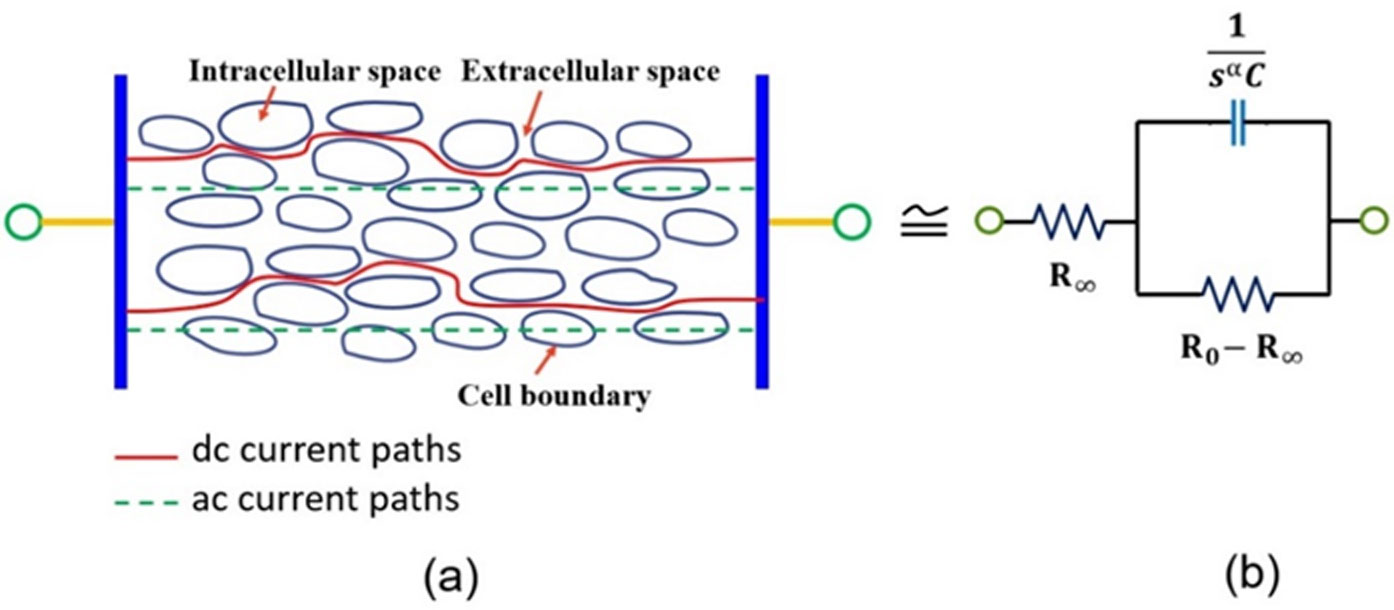









 DownLoad:
DownLoad:
